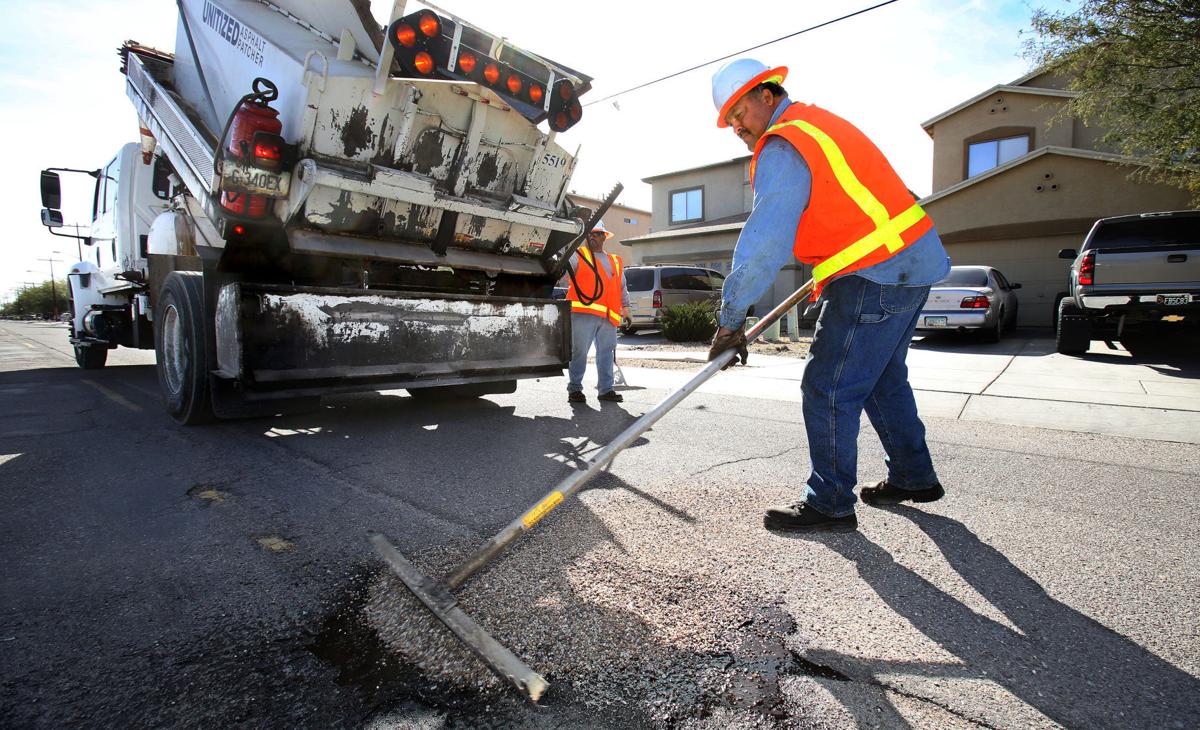Even with the new road property tax, it could be many years before some crumbling neighborhood streets see any repairs.
That is, unless, neighbors band together and form what is known as an improvement district. Those special taxing districts allow residents in unincorporated Pima County to essentially impose an assessment or property tax on themselves — only after a majority within designated boundaries sign a petition — to pay for streets, lighting or other improvements in the area.
“It’s a mechanism for homeowners to have control and help themselves,” Keith Dommer, the county’s finance director, told the Road Runner.
And recently that prospect has sounded at the very least intriguing to a number of county neighborhoods, especially in Green Valley. Six neighborhoods with well over 1,000 individual properties have inquired about the improvement district process this year and three have formally requested petitions, according to documents obtained through a public records request.
However, two of the three have formally suspended their efforts, at least temporarily, for interesting reasons.
Chuck Dorr, president of the Portillo Hills II homeowners association, said it’s the prospect of a county-imposed half-cent sales tax that led him to slow things down. He recently heard about Supervisor Steve Christy’s proposal for such a tax, which requires a challenging unanimous board vote but could bring in millions more annually than the current 25-cent road property tax.
“We didn’t want to do it before we found out that there was money available,” Dorr said of a possible improvement district.
After all, who wants to live in the neighborhood that decided to tax itself for road repairs that could have ultimately been done by the county? But even if the sales tax is approved, Dorr said the neighborhood would need to find out “if we’re going to be far enough up the list to where we can hope for county money to fix our roads, or if we need to consider doing them ourselves.”
A little ways south along Calles Montanoso and Lecho, Bart Kolodziejczak has also hit the brakes on his neighborhoods improvement district, but not because of the prospect of a sales tax.
Instead, Kolodziejczak said it’s the fact that there is no longer the possibility of the county covering half of the estimated $102,000 repair costs, with the neighborhood picking up the tab.
“Please note, in order to improve more roads in Green Valley, the Green Valley Council had previously suggested splitting costs 50/50,” the finance department’s Naomi Romano wrote Kolodziejczak in late September. “Since that time, the property road tax went into effect. That has negated any other proposals, including the 50/50 split …”
Dommer told the Green Valley News that a promise to cover half the cost was never made. He later told the Road Runner that the county has “a longstanding willingness to pay for part of projects.” However, with the approval of the property road tax and the formation of the Pima County Transportation Advisory Committee, which is tasked with approving recommendations for roads to repair with the tax’s proceeds, the county delegated the task of prioritizing projects to the committee. Dommer said the committee could still consider such an arrangement.
Kolodziejczak said a sizable majority of his neighbors had expressed interest in forming a district, but only with the halfsies arrangement. With only 12 properties in the proposed district, the individual share for the full price tag would be steep.
“Nobody on the street is going to pay 100 percent,” he said.
At the same time, Kolodziejczak has a dim view of both the prospects for a sales tax and the likelihood that its proceeds would even make it to his neighborhood if it is approved, not leaving him with many options.
“People in Green Valley are not young. We want our roads fixed before we die,” he said.
The half-and-half approach is not entirely off the table though, and the Green Valley Council’s Don Weaver told the Road Runner that his organization intends to recommend that the advisory committee consider it at its next meeting. The committee’s chair, Lucretia Free, said that while the committee has adopted criteria that generally exclude low-volume, failed roads, it has also left room for consideration of projects that fall outside of those bounds.
But even with that door still open, petitioners still have to get a majority of their neighbors on board. Joe McCalpin, who’s a board member of the Green Valley’s Esperanza Hills HOA, said that could be a tall, divisive order in some places. He said he’s exploring improvement districts so that they can be “presented as an option for the homeowners to discuss,” though he’s personally “not sure I’m in favor of it.”
With many friends and neighbors living on fixed and modest incomes, McCalpin thinks a sizable share of homeowners could be “stressed” by the new expense. Tensions could build between supporters and opponents, a distressing possibility given what McCalpin described as tight-knit community that regularly puts on lively, well-attended events.
“It has the potential of tearing the community up,” he said.
Like Dorr, McCalpin said his neighborhood is likely to wait and see how the sales tax fares before moving forward.
DOWN THE ROAD
- Eastbound and westbound Interstate 10 will be reduced to one lane at milepost 268 overnight from 8 p.m. to 5 a.m., Monday through Thursday, to accommodate bridge work. Any vehicles wider than 16 feet will be required to exit at Craycroft Road. The $3.3 million bridge project is expected to be done later this year.





